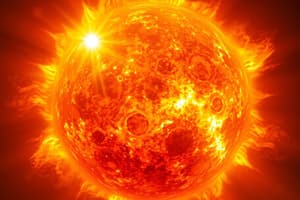Podcast
Questions and Answers
What is the primary process occurring in the Sun's core that produces energy?
What is the primary process occurring in the Sun's core that produces energy?
- Gravitational contraction
- Chemical reactions
- Nuclear fission
- Nuclear fusion (correct)
Which two gases primarily make up the Sun?
Which two gases primarily make up the Sun?
- Carbon dioxide and argon
- Methane and ammonia
- Oxygen and nitrogen
- Hydrogen and helium (correct)
Which of the following is NOT a characteristic of objects in the Solar System?
Which of the following is NOT a characteristic of objects in the Solar System?
- Distance from the Sun
- Composition and surface temperature
- Number of moons
- Presence of life (correct)
What region of the Solar System contains icy objects beyond Neptune?
What region of the Solar System contains icy objects beyond Neptune?
How many planets orbit the Sun in our Solar System?
How many planets orbit the Sun in our Solar System?
What is the primary process through which the Sun generates energy?
What is the primary process through which the Sun generates energy?
What is the approximate temperature at the core of the Sun?
What is the approximate temperature at the core of the Sun?
Which of the following accurately describes a characteristic of objects in the solar system?
Which of the following accurately describes a characteristic of objects in the solar system?
What is the primary gas that makes up the Sun?
What is the primary gas that makes up the Sun?
What causes the variance in the time it takes for different objects to orbit the Sun?
What causes the variance in the time it takes for different objects to orbit the Sun?
Flashcards
What is the Sun?
What is the Sun?
The Sun is a massive star, like others, that generates heat and light continuously. It's primarily composed of hydrogen gas.
How does the Sun produce energy?
How does the Sun produce energy?
The Sun's energy is created by nuclear reactions within its core, where hydrogen transforms into helium.
What are the temperatures of the Sun's surface and core?
What are the temperatures of the Sun's surface and core?
The Sun's surface temperature is around 5500°C, while its core reaches a staggering 15 million °C.
What objects exist in our solar system?
What objects exist in our solar system?
Signup and view all the flashcards
What determines the time it takes for objects to orbit the Sun?
What determines the time it takes for objects to orbit the Sun?
Signup and view all the flashcards
What is nuclear fusion?
What is nuclear fusion?
Signup and view all the flashcards
What are the planets in our Solar System?
What are the planets in our Solar System?
Signup and view all the flashcards
What else orbits the Sun besides planets?
What else orbits the Sun besides planets?
Signup and view all the flashcards
How do objects in the Solar System differ?
How do objects in the Solar System differ?
Signup and view all the flashcards




